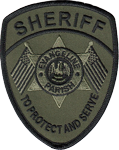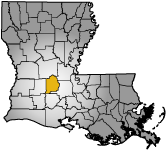SECTION: 618 PURSUIT DRIVING
SECTION: 618
TITLE: PURSUIT DRIVING
RESCIND: February 15, 2017
EFFECTIVE: JUNE 30, 2025
PURPOSE: This order establishes operational procedures for pursuit driving.
POLICY: It shall be the policy of the Evangeline Parish Sheriff's Office to ensure the safety of the public and department employees by enforcing strict standards for the operation of Evangeline Parish Sheriff's Office vehicles in emergency response situations.
SCOPE: This policy/procedure governs the actions of all deputized personnel when involved in or considering involvement in pursuit driving and/or the use of emergency lights and siren.
PROCEDURE:
- Pursuit Driving
- A pursuit shall be defined as an event involving one or more deputies attempting to apprehend a violator in a motor vehicle where the violator is trying to avoid capture by driving at a high speed, engaging in other evasive tactics or by maintaining a legal speed but willfully failing to stop at the deputy's direction. Under normal circumstances, there should be no more than two units actively engaged in a pursuit at the same time unless authorized by the Patrol supervisor.
- Determining when to initiate a pursuit:
- A deputy shall consider the following factors before pursuing a suspect fleeing in a motor vehicle:
- The performance capabilities of the police vehicle.
- The seriousness of the violation.
- The condition of the roadway surface(s) traveled.
- Weather and traffic conditions.
- The risk involved to the public and to the deputy in initiating the pursuit.
- The ability to positively identify the violator for later apprehension.
- All deputies shall be aware of the inherent danger to the public and to themselves in high-speed chases. If initiating or continuing a pursuit is more dangerous to the public than the suspect's remaining at large, deputies shall not pursue the suspect. If an imminent injury or property damage becomes apparent during any high-speed chase, the police vehicle shall be slowed to a safer speed.
- A deputy shall consider the following factors before pursuing a suspect fleeing in a motor vehicle:
- Primary officer's responsibility:
- Assess the situation and decide whether or not to pursue based on factors listed previously.
- Obtain permission to pursue from shift supervisor.
- After approval, activate all emergency lights and siren
- Notify the dispatcher and give the following information:
- Unit number.
- Nature of the emergency or reason(s) for the pursuit.
- Where the pursuit began.
- Direction of travel, location, and speed of the fleeing vehicle.
- Description of the fleeing vehicle.
- Description and number of occupants in the vehicle.
- Any possible hazards to assisting deputies.
- Conduct the pursuit as safely as possible.
- Notify the dispatcher upon termination of the pursuit.
- Make, or assist in the arrest of the suspect.
- Assume control of the scene, unless relieved by a supervisor.
- Assisting officer's responsibility:
- Notify the dispatcher upon joining the pursuit.
- Broadcast location, direction of travel and other necessary information to dispatcher and other units.
- Assume the position of the primary pursuit vehicle should the primary pursuit vehicle become disabled.
- At the termination of the pursuit, the driver of the secondary pursuit vehicle shall broadcast pertinent information (e.g., location and suspect information).
- Primary dispatcher's responsibility:
- Clear (10-33) primary channel of all unnecessary traffic, until such time that all participating units can switch to a scene frequency.
- Have all units not directly involved in the pursuit switch to an alternate radio frequency, until the primary frequency can be cleared.
- Notify appropriate zone unit(s) if the pursuit enters their zone and advise where to respond.
- Advise pursuit vehicles of known hazards in the path of pursuit.
- Determine why the vehicle is fleeing.
- Notify other agencies, using the *700 BOLO Radio, in the event the fleeing vehicle and pursuing unit(s) are headed towards the parish limits of St. Landry and could enter their jurisdiction.
- Shift Supervisor's responsibilities:
- The Shift Supervisor shall monitor all actions of the field units and the dispatcher to ensure that Department procedures regarding high-speed pursuits are being observed.
- The Shift Supervisor shall order a pursuit terminated when conditions become such as to endanger the public or the deputies involved.
- Field Supervisor's responsibilities (If Applicable):
- Field Supervisors shall monitor all radio communications to ensure that only those units authorized and designated by the dispatcher participate in the pursuit.
- Field Supervisors shall order a pursuit terminated when conditions become such as to endanger the public or the deputies involved.
- Police vehicles eligible to engage in pursuits:
- Only Department vehicles equipped with operable emergency lights and sirens will participate in the pursuit of a fleeing vehicle.
- Department vehicles that are transporting prisoners, witnesses, suspects, complainants or other non police personnel shall not engage in pursuits.
- Motorcycle deputies who initiate pursuits shall discontinue their involvement immediately when a marked police unit with operable emergency equipment enters into the pursuit.
- Deputies in unmarked vehicles, who have probable cause to believe a criminal offense has taken place and police action is warranted, may attempt to follow a fleeing vehicle but shall discontinue their involvement when a marked police unit with operable emergency equipment enters into the pursuit.
- Guidelines for Pursuit Driving:
Employees shall abide by Louisiana Revised Statute 32:24 which governs the use of emergency vehicles.- No maximum speed limit is set for pursuit situations.
- Employees involved in a pursuit situation shall come to a complete stop for all stop signs and traffic signals emitting a red signal for their directional flow of traffic. They may proceed through the intersection only after affecting a complete stop and observing that the roadway is clear to do so without posing danger.
- Employees involved in pursuit situations shall make full use of the emergency lights and audible signal (siren).
- After a pursuit has been initiated, all units not directly involved in the pursuit will switch radio frequencies as directed by the dispatcher.
- When transmitting, deputies shall remain as normal and coherent as possible to avoid distorting transmissions.
- Patrol vehicle windows shall be closed in order to enhance radio communications. Deputies involved in pursuits will maintain continuous and coherent communications with the dispatcher. The secondary unit will be responsible for all radio communications, providing frequent updates on location, speed or other unusual activities committed by the fleeing vehicle.
- The pursuit shall be terminated:
- When the immediate danger to the public created by the pursuit exceeds the immediate or potential danger presented by the violator's remaining at large.
- When the danger to the public outweighs the danger resulting from the initial violation or reason for initiating the pursuit. Supervisors shall order a vehicular pursuit discontinued when the circumstances do not justify continuing the pursuit.
- Number if units participating in pursuits:
- The police unit initiating a pursuit shall be designated as the assigned unit.
- A backup or secondary, police unit designated by the dispatcher shall be the only other police vehicle entering the pursuit unless one of the following exists:
- The assigned unit requests additional units believing those assigned are not sufficient to safely arrest the suspect(s).
- The assigned unit is unable to continue the pursuit. The secondary unit then becomes the primary unit.
- The Shift Supervisor may authorize additional police units to join the pursuit.
- Roadblocks:
- Roadblocks may be used as a last resort to apprehend a suspect who shows a total disregard for his safety and the safety of others.
- Authorization to set up a roadblock will come from a Shift Supervisor directly involved in the pursuit and only after receiving permission from the shift supervisor.
- Roadblocks shall be set up in a conspicuous manner using emergency lights.
- Roadblocks will be constructed to leave the fleeing driver an opportunity to stop or to leave the fleeing driver a way out if he chooses not to stop.
- Occupied vehicles and/or private vehicles shall not be used as a roadblock.
- Marked police vehicles with operable emergency lights shall be the only vehicles used in a roadblock.
- Information concerning roadblocks, which have been set up, shall be relayed by the Shift Supervisor to all units involved in the pursuit.
- Restrictions:
- The following methods of stopping a fleeing vehicle shall not be attempted unless authorized by the Shift Supervisor and the officer is trained in utilizing such method(s).
- Attempting to force the fleeing vehicle off the roadway by use of a police unit.
- Positioning the police unit in front of the fleeing vehicle in an attempt to slow down or stop the fleeing vehicle.
- Bumping or ramming the fleeing vehicle in an attempt to force it from the roadway.
- Deployment of road spikes.
- Deputies shall not shoot from or at a moving vehicle, with the exception of the following circumstances:
- When the suspect poses a threat of death of serious physical injury to either the deputy or another, and;
- When all other reasonable means of defense have failed.
- Parallel pursuits are strictly prohibited. Deputies shall not utilize emergency equipment, nor shall they exceed the speed limits in an attempt to follow, catch up to or keep up, with the pursuit on parallel streets. The only exception shall be under the following circumstances:
- A supervisor may authorize units to utilize emergency equipment to reach possible roadblock location if such a determination has been made.
- The unit has been specifically instructed to catch up to or become involved in a pursuit by a supervisor.
- These restrictions are not to be constructed as to prevent deputies from proceeding toward the area of the pursuit at normal speeds and without use of emergency equipment.
- The following methods of stopping a fleeing vehicle shall not be attempted unless authorized by the Shift Supervisor and the officer is trained in utilizing such method(s).
- Implementing and coordinating multi-channel pursuits:
- Shift Supervisors shall be responsible for implementing multi-channel pursuits.
- To implement a multi-channel pursuit, the Shift Supervisor shall do the following:
- Pursuits by the St Landry Parish Sheriff's Office that extend into other jurisdiction.
- Notify the dispatcher to contact the appropriate agency of current jurisdiction.
- If possible, have the dispatcher patch the other agency's frequency to into the Department's scene frequency and advise the assigned unit that radio contact may be made with the other agency on the same frequency.
- Monitor the pursuit.
- Coordinate the field operations of all agencies participating in that pursuit.
- Other Agency pursuits entering the Parish limits:
- Notify the Shift Supervisor and Dispatcher that our assistance has been requested by another agency that has initiated a pursuit.
- The Shift Supervisor shall assign the appropriate unit(s) and advise these units to respond.
- The dispatcher, if possible, will patch the other agency's frequency to the Department's frequency.
- At no time shall any unit, other than those authorized to participate in the pursuit, transmit information over the channel designated for the pursuit traffic.
- Offense Report containing the following shall be completed:
- The date, time, and location where the pursuit was initiated.
- The Violations observed, or reason for the pursuit.
- Vehicle and suspect description(s).
- The path of the pursuit, including any traffic violations observed.
- The manner in which the pursuit ended.
- If the pursuit was terminated, an explanation of why will be included.
- Pursuits by the St Landry Parish Sheriff's Office that extend into other jurisdiction.
In regards to: All Rules, Regulations, Policy & Procedures and Special Orders are at the discretion of the Sheriff based on departmental need and the severity of the infraction.



